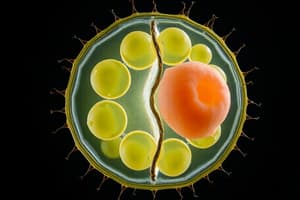Podcast
Questions and Answers
What is the primary role of oncogenes in the cell cycle?
What is the primary role of oncogenes in the cell cycle?
- To reduce the rate of cell division
- To promote the formation of somatic cells
- To initiate apoptosis in damaged cells
- To accelerate the cell cycle (correct)
What is the end product of meiosis in terms of chromosome number?
What is the end product of meiosis in terms of chromosome number?
- Triploid cells (3n)
- Haploid cells (n) (correct)
- Diploid cells (2n)
- Tetraploid cells (4n)
Which genetic condition is characterized by the presence of an extra X chromosome?
Which genetic condition is characterized by the presence of an extra X chromosome?
- Down syndrome
- Turner syndrome
- Klinefelter syndrome
- Trisomy X (correct)
What process describes the random distribution of chromosome pairs during meiosis?
What process describes the random distribution of chromosome pairs during meiosis?
What is the result of nondisjunction during meiosis?
What is the result of nondisjunction during meiosis?
What is the primary function of cell division in relation to growth and development?
What is the primary function of cell division in relation to growth and development?
What are sister chromatids?
What are sister chromatids?
During which phase of the cell cycle does DNA replication occur?
During which phase of the cell cycle does DNA replication occur?
What is the primary characteristic of malignant tumors?
What is the primary characteristic of malignant tumors?
What role do telomeres play in cellular function?
What role do telomeres play in cellular function?
What process is described as an orderly programmed cell death?
What process is described as an orderly programmed cell death?
In which stage of mitosis do chromosomes align in the center of the cell?
In which stage of mitosis do chromosomes align in the center of the cell?
What is the primary function of cytokininesis?
What is the primary function of cytokininesis?
Flashcards are hidden until you start studying
Study Notes
Cell Division Overview
- Cell division, or cell reproduction, is essential for growth, development, and the replacement of old cells.
- Asexual reproduction generates offspring from a single parent without gamete involvement, while sexual reproduction requires two gametes from parents.
DNA and Chromosomes
- DNA is a double-stranded molecule organized into chromosomes.
- Chromosomes are long, continuous threads of DNA associated with histones, which help package the DNA.
- Each body cell contains 46 chromosomes, organized into 23 pairs.
- Chromatin facilitates efficient DNA packaging, while a chromatid is a duplicated strand of a chromosome, with sister chromatids connected by a centromere.
Cell Cycle Stages
- The cell cycle includes Interphase and M phase (mitosis and cytokinesis).
- Interphase consists of three main phases:
- Gap 1 (normal metabolic activities)
- S phase (DNA replication)
- Gap 2 (additional growth)
- Mitosis involves division of the nucleus into two identical nuclei, with key phases being prophase, metaphase, anaphase, and telophase.
- Cytokinesis divides the cytoplasm and often begins in late anaphase or telophase, forming a cleavage furrow with microfilaments.
Apoptosis and Cancer
- Apoptosis refers to programmed cell death for maintaining health.
- Cancer is characterized by uncontrolled cell division, leading to tumors: benign tumors remain localized, while malignant tumors can metastasize (spread).
Cell Cycle and Genetics
- Oncogenes promote accelerated cell cycling, impacting cancer progression.
- Treatment options for cancer include surgery, radiation therapy, and chemotherapy, targeting actively dividing cells.
- Zygotes result from the fertilization of sperm and egg cells, with meiosis producing haploid sex cells.
Meiosis and Genetic Terms
- Meiosis results in the formation of gametes (sperm and egg cells) via spermatogenesis and oogenesis.
- Key genetic concepts include:
- Independent assortment (random distribution of chromosomes)
- Nondisjunction (failure to separate chromosomes, leading to disorders like trisomy and monosomy)
- Turner syndrome (single X chromosome), Down syndrome (three copies of chromosome 21), Klinefelter syndrome (extra X chromosome), and Trisomy X (extra X chromosome).
Chromosomal Structures and Karyotyping
- Homologous chromosomes share length and genetic traits, while karyotyping involves arranging chromosomes visually.
- A karyogram displays these arranged chromosomes, with sex determination revealed by the presence of XX (female) or XY (male) chromosomes.
Studying That Suits You
Use AI to generate personalized quizzes and flashcards to suit your learning preferences.




